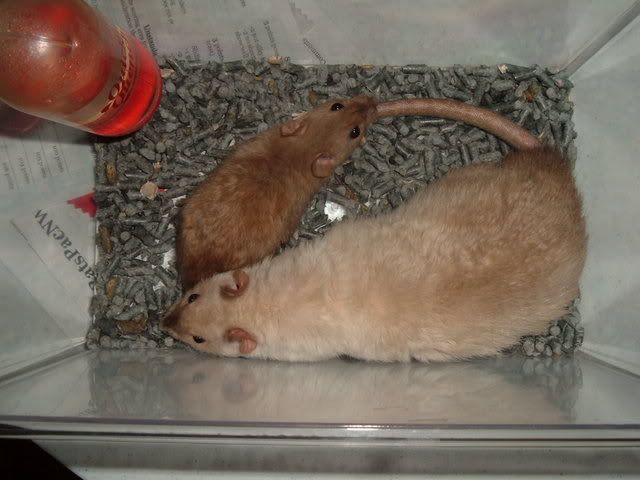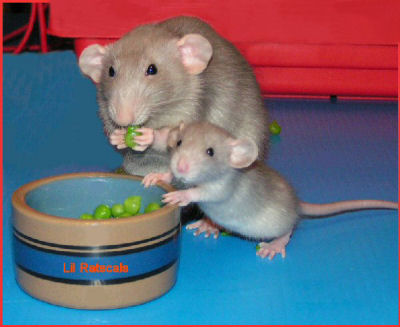Welcome Viewers
Search Here

Updates on Rats For Pets
Saturday, March 29, 2008
Potty Training Your Rat
Wednesday, March 26, 2008
Different Breeds of Rats
 Hairless Rat
Hairless RatTuesday, March 25, 2008
30 Fascinating Facts
4. A high-ammonia environment (caused by poor cage-cleaning habits) and stress are major predisposing factors to respiratory disease.
5. If a rat is slobbering, it may be suffering from heat-stroke or a dental problem.
6. Rats sometimes produce "red tears." The fluid is alarmingly blood like in appearance, but it actually has a red pigment in it called porphyrin. Healthy rats may randomly give off this substance, but a persistent discharge may be a sign of sickness or stress.
Physiology
Reproduction
Sorry, but that is all I have about reproduction.
Behavior
21. "Bruxing" (grinding of the teeth) is a form of rat communication that could mean your rat is relaxed - so if your rubbing behind its ear, it might "bruxe." However, it could mean your rat is stressed.
These are pictures of capybaras.
Benefits of Having More Than one Rat
Sunday, March 23, 2008
Grooming Your Rat and Bathing It
Saturday, March 22, 2008
Chattering of the Teeth - and other weird things
....................................................................................................................................
You might have also noticed a sort of red-crust around your rats eyes when they wake up when you come to visit them. That is nothing to worry about. Rats have a red pigment in their tears, so all that it is, is dried up tears. Nothing to worry about. If you don't like the way it looks, (I don't) just very gently rub them off.
Friday, March 21, 2008
Homemade treats

The picture above, is a picture of my rat, LuLu, eating one of the peanut butter treats. She loves them.
Answers to Your Questions From the Comment Box
Question #1. Someone asked if that was my dog in the picture under the post, "Me and My Blog" to answer your question. Yes, that is my dog in the picture. In case you were wondering what kind of dog he is, he is a Bernese Mountain Dog. He ways 120 pounds and is named Rex. Here is the same picture:
Someone asked if I have heard of a rat living 7 years (130 human years). To answer your question, no, I haven't, and I don't think it is possible because I don't think a human has ever lived over 130 years. Although my last rat lived pretty long. She live to be about 2 and a half years old, maybe even longer. So she lived to be about 75 human years. The rat that lived that long was named Daisy and she is in the picture above on top of my dog's head. For more information on how long rats live compared to humans click on "How Long do Rats live - really cool" and that is under March 19.
Someone else asked a question in which I thought was very important. Someone asked, "what should i do to tell my kid that her rat is dying???????" That is a very important question because one of the hardest things to go through when having a rat is if they are dying. Especially if you have to tell it to a child. My last rat, Daisy, was getting old, she was about 2 and a half to 3. And she was going blind, losing her hearing, and had a huge tumor. I hated to see her like this. One day when I came home, I took her out of her cage, and wrapped her in a blanket so she'd stay warm, because I knew she was dying. She soon fell a sleep in my lap. After a little while she woke up, crawled up on my chest, had a seizure for only like 8 seconds, and right on my chest she died. In just 8 seconds. Hopefully that won't happen to your child. But there are some ways to tell your kid that their rat is dying. A good way to tell it to them is to say, "I'm very sorry but your rat is going through a tough time and is very sick and we will do every thing we can to try to make her better." Even if your almost positive your rat is going to die you still shouldn't tell them that, it won't make them feel better. Tell the child "you'll do everything you can to help." If death comes you should tell him or her, "Your rat lived a good and happy life and you took great care of him, but it was time for her to go. And in heaven she's not sick any more and in heaven she's living with lots of rats, and she's happier now." If your child's rat had tumors tell him or her, "Now she has no more tumors and she can walk a lot better now. I'm sure she wouldn't be any happier with another owner than she was with you. You took such great care of her" What I just told you to say shouldn't be the only thing you should say, these are just some ideas. I hope this advice didn't come to late I was very sick for 10 days, but now I'm better.
Thank-you for asking questions and leaving comments. Any other questions I'll try to answer as soon as possible!
Thursday, March 20, 2008
Mycoplasmosis
Tumors
Wednesday, March 19, 2008
Healthy Snacks
How Long Do Rats Live? - Really Cool
Rat Age Human Age
5 weeks ................................ 10 years
6 months ................................ 16 years
9 months ................................ 25 years
1 year ................................. 35 years
1 1/2 years ............................. 50 years
2 years ................................ 65 years
3 years ................................ 85 years
4 years ................................ 100 years
5 years ................................ 110 years
6 years ................................ 120 years
7 years ................................ 130 years
Recommendations on rat supplies.
What to do when I get home right away.
Tuesday, March 18, 2008
Picking the Right Rat for You

Should I get a rat? What are the requirements?
Me and My Blog

Rats are great pets to have, but there are some things you need to know to take care of them. I have had many rats. I got my first rat when I was just six. Since then I have gotten many books about rats and have done much research to help my rats be healthier and live longer. Rats are great pets to have and never bite. I have never been bitten by any of my rats and only licked. Although hamsters bite. If you would like to learn lots about rats and how to take care of them,my blog has very good and precise information. Right now I do not have very much information, but very soon I will have a lot mor information. Please post comments so I can improve my blog, no email address required!







